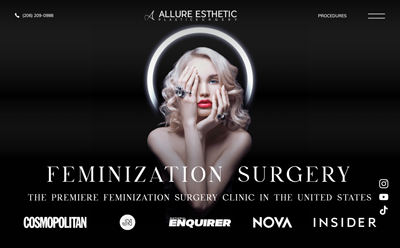A rhinoplasty surgery—also called a nose job—is one of the most popular aesthetic surgeries performed around the world. Nose jobs vary in the exact procedures performed and the extent of those procedures. But, some side effects are expected after surgery. Luckily, most side effects are minor, treatable, and will go away over time.
Let’s look at some of the most common rhinoplasty side effects and how to reduce them.
Rhinoplasty of Side Effects
#1: Swelling
Swelling is common after most surgeries. Following a nose job, swelling will likely distort the final look of the nose. It can make the bridge appear wider, the nose look larger, and misshapen. This is completely normal and part of the healing process. Some people may experience more swelling than others.
To reduce the severity and duration of swelling, patients should limit exercise and strenuous activity. Icing the area is also okay within the first few days. Patients should also elevate their head when sleeping or resting. Depending on the specifics of surgery, massage may also help relieve swelling.
#2: Bruising
Bruising is another common nose job side effect. Depending on the extent of the surgery, bruising may include one or two black eyes, or it may be limited to the nasal area. Bruising appears between one and three days after surgery and can last as long as two weeks. But, most bruising resolves before then.
Minimizing bruising can involve taking arnica supplements after surgery, limiting activity, avoiding certain medications that can worsen bruising like NSAIDs, and not drinking alcohol post-surgery. Some people are more susceptible to bruising than others.
#3: Redness
Redness, especially on or near the incision site, is a frequently observed side effect of rhinoplasty surgery. It may be more prominent on people with lighter skin tones, or if a patient experiences worsened irritation, bleeding, or infection. Most of the time, redness is nothing to worry about and should go away within a few days.
Unfortunately, there is not a great way to reduce redness associated with surgery. Ensure it does not worsen or feel hot to the touch. Other normal aftercare procedures can help the redness. To prevent scar redness, patients should keep their scar protected from the sun for at least three months post-surgery. Long term effects of rhinoplasty can include ongoing redness of the incision or scar.
#4: Pain/Discomfort
Pain and discomfort—like after most surgeries—is expected. Patients often receive prescription pain medication to help manage their pain immediately after surgery. After three to five days, most patients can manage their post-surgery pain with over-the-counter options.
Taking their medications and avoiding bending over or undue physical activity helps limit pain. Patients should also avoid touching the area and follow their surgeon’s instructions.
#5: Nasal Congestion
After a rhinoplasty, the nasal passages can become clogged with both surgical debris (blood and scabbing) and mucus. This can help protect the inside of the nose and nasal passages as they heal. Patients may have also have internal splints in their nose which can worsen the feeling of congestion.
In many cases, patients can begin flushing out their nose with a saline rinse within a few days of surgery. This washes out the blood and mucus, leading to increased patient comfort and keeping the surgical area clean. Patients should not blow their nose or try to pick their nose to address the congestion.
#6: Skin Discoloration
Skin discoloration can be normal—such as redness or bruising—but it can also be a long term effect of rhinoplasty. The skin surrounding the scar may become discolored in comparison to the skin around it. This may resolve over the course of the first year. Keeping the area out of the sun and protected can help prevent worsened discoloration. It can also prevent it from occuring in general.
While rare, notable discoloration that does not go away within time and basic aftercare may require treatment to address such as chemical peels or laser resurfacing. Usually, this will not begin until one to two years after surgery.
#7: Bloody Nose
A bloody nose after surgery is normal, but it should not be gushing blood nor should it continue to happen more than two or three days after surgery. A surgeon may send their patient home with packing in the nose that is meant to catch the blood and place gentle pressure on the area to stop the bleeding. The patient may also recieve extra packing to replace it when necessary.
While not completely avoidable, it is important for patients to avoid medications and substances that can worsen bleeding. Patients should follow their surgeon’s instructions and not let additional trauma happen to the area, which can worsen or prolong bleeding in the nose.
Conclusion
Rhinoplasty side effects are usually expected and normal, but patients can take steps to work to prevent or lessen the severity of the side effects. This can start at the consultation appointment by providing the surgeon with a full and comprehensive medical history which can help the surgeon create a personalized surgical plan.
 FeminizationSurgeries.com
FeminizationSurgeries.com
